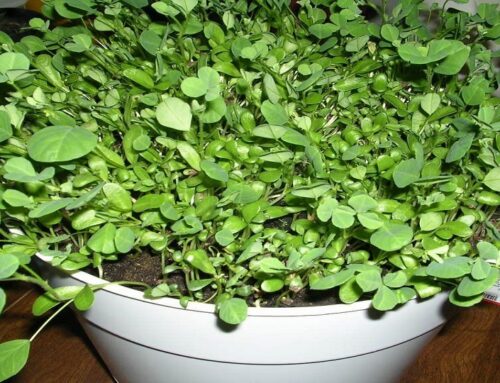Amaranth greens are popular leafy greens throughout the world. Several cultivars of amaranth plant are used as leafy vegetables; some are with green leaves, some with greenish-red leaves while others are with red leaves. However, all cultivars are grown only during the summer and the rainy seasons.
In kitchen gardens, amaranth greens can be grown throughout the year in pots and other containers, provided that sufficient care is provided for the plants from frost protection during winters.
Taxonomy: Amaranth plant belongs to the family Amaranthaceae. Botanically, it is written as Amaranthus spp. These plants are believed to be native of Americas.
There are several cultivated species of Amaranth plants; however eight species are very popular among kitchen gardeners. A list of these cultivated species of amaranth greens is given below:
Cultivated Species of Amaranthus: A list of various cultivated species of amaranth greens is given below:
- Amaranthus blitum–Leaves are cooked, seeds are also used as substitute to cereals in some parts, used as an edible diet, leaf extract is used to treat mouth ulcers and sores.
- Amaranthus cruentus–Leaves are cooked, seeds are used to prepare cakes, and flowers are used as coloring agents.
- Amaranthus hybridus–Leaves are cooked either as part of the diet or added with soups, the flour of the seeds are used to prepare cakes etc, the tea made by adding amaranth is used to treat intestinal bleeding, excess menstruation and diarrhea.
- Amaranthus retroflexus–Leaves are cooked, used as substitute to cereal, useful to treat intestinal diarrhea and intestinal bleeding.
- Amaranthus caudatus–Generally seeds are produced and consumed.
- Amaranthus mangostanus–Leaves are cooked, used as a substitute to cereal, consumed as edible dye too.
- Amaranthus lividus–Leaves are cooked or eaten as raw, the leaves are also processed.
- Amaranthus dubius–Leaves are cooked and consumed, also help in preventing health related problems like constipation, anemia, fever and hemorrhage.
Growing Amaranth Greens in Kitchen Gardens: It is easy to grow amaranth plants. Choose a good location with plenty of sunlight for growing amaranth greens.
Remember, amaranth is a seasonal crop and all amaranth cultivars are suitable for growing in the summer as well as the rainy season. However, Amaranthus blitum is one of the most suitable cultivar for growing in kitchen gardens. This cultivar is suitable for sowing in spring season too so that it gives green leaves throughout the summer. A.blitum plants are dwarfish with small leaves and rejuvenate quickly after each harvesting of leaves.
Amaranth plants prefer well drained sandy loam soils for their growth. Soil should have sufficient water holding capacity and rich in organic matter. Since vigorous leafy growth is preferred in all leafy greens, it is good for the plant growth if soils are kept moist always.
Amaranth plant is propagated through seeds. Seeds are very small, and hence shallow sowing is recommended in the nursery beds and/or open fields. If plants are grown in containers, seeds may be sown directly in the soil-filled containers.
Seeds are sown by broadcasting in rows or in flat beds after mixing them with fine sand for uniform distribution. Approximately 10 grams of seeds is sufficient for planting in 500 sq. ft. area.
Light watering is done soon after sowing. Distance between two rows may be kept at 20 cm. Seeds germinate within a week. Thinning may be done when seedlings are half an inch tall or when they have at least two-sets of leaves. Seedling are ready for transplanting after 2-3 weeks of sowing. If seedlings are raised in nursery beds, transplanting is done during rainy season. Recommended spacing during rainy season is about 45 cm from row to row and 30 cm from plant to plant.
Amaranth plants need to be watered on regular basis, all throughout its vegetative growth phase. During its active growth phase, small amounts of nitrogenous fertilizers such as urea or fully decomposed organic manures may be added to the soil to enhance soil fertility.
For container-grown plants, foliar application of urea or liquid nitrogen may be given.
Amaranth plants are fast-growing and are very easy to grow in kitchen gardens. Under good cultural practices, amaranth grows vigorously to a height of 1-1.5 meter.
There are no serious insect-pests or diseases are found affecting amaranth greens. Sometimes leaf borers may be an issue. In that case, use tobacco extracts or pyrethrum extracts to control them. it is not advised to use chemical pesticides on any leafy greens as a pest control measure. Since leaves are harvested for fresh use, sometimes for salad purposes, care should be taken not to treat leafy greens with any of harmful chemicals.
Harvesting of young, tender leaves usually starts 4 weeks or one month after sowing. Normally, amaranth plants reach maturity after 2 months of seed sowing. However, for using the leaves for vegetable purposes, tender leaves are preferred and harvesting may begin one month after sowing. One crop/plant gives about 4-6 harvests of leaves. Leaves are handpicked or cut with a sharp knife leaving the bud for next harvest.
Seed Production in Amaranth Greens: For seed production, the plants after last harvest are left as such to let them reach to full maturity. When the whole plant dries, the seeds are separated from rest of the plant parts. Seed yield per acre is about 100 kilograms.
We have a book on ‘Leaves as Vegetables‘….
Check out our publishing services here…
We publish top quality videos on various ‘Food & Agriculture’ topics. You may subscribe our video channel here…






